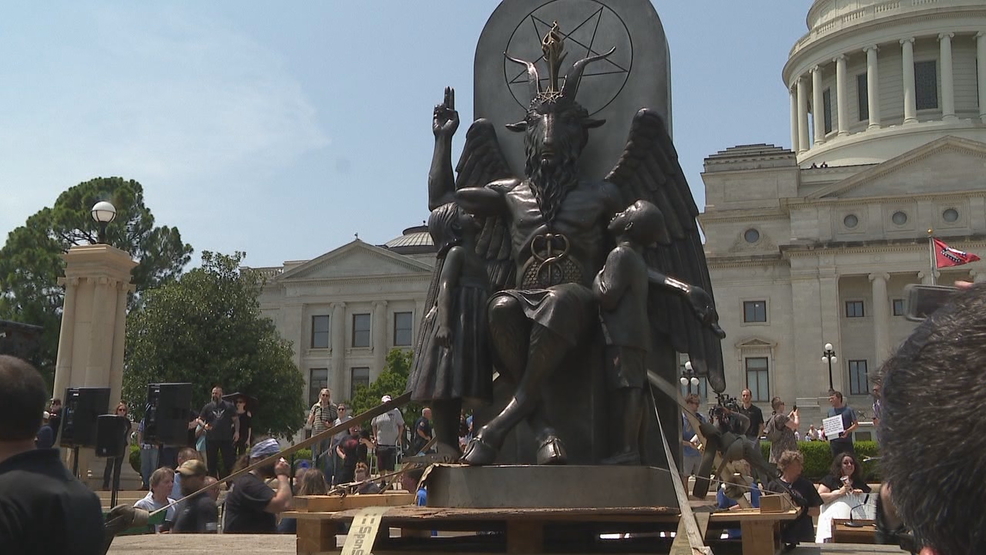
If everything goes according to plan (or, better: according to my current ideas), I will write my RMA thesis on a case that I stumbled upon at the International Film Festival Rotterdam (IFFR): the documentary film Hail Satan?, directed by Penny Lane (2019).[1] Lane sets out to represent the ideals and considerations of an American organization, the Satanic Temple, that pursues religious freedom, the separation of church and state and social equality in the US. The film’s point of departure is an actual controversy that dates back to August 16, 2018, when members of the Temple temporarily installed a statue of the goat-headed Baphomet (a representation of Satan) before Arkansas State Capitol (the seat of the state government).
There is a lot to tell about this topic. For the sake of scope, however, I have decided to use this entry in a rather strict way. Since any proper proposal on this controversy, the film case and my research questions [presented at an RMA tri-university conference in June 2019] will at all times encompass (a) section(s) on methods and theories, I use this entry to probe one specific concept, asking myself whether or not this concept could be helpful to better understand this particular case.
Religioscapes
In their article ‘Intersecting Religioscapes’ (2013), Robert M. Hayden and Timothy D. Walker unpack their conceptualization of the ‘religioscape’, a term that they coin to analyze cases of shared and contested religious space.[2] They start with an outline of former scholarship on shared religious space, in which processes of sharing and co-existence were often understood as chronologically and spatially confined manifestations of tolerance – more in the sense of embrace and active acknowledgement (Mill) than in a more Lockian conception of endurance. From there Hayden and Walker build their case for a conceptualization that pays ample attention to religious spaces that [a] extend and transform over time and [b] feature in contexts of competition and conflict.[3]
The authors use the model of Antagonistic Tolerance (AT) to discuss the findings of their comparative research on several religious spaces.[4] In the AT model, they write, ‘’contestation develops in a region in which one religious tradition is dominant when a community identified with a differing religion arrives via trade, warfare, migration, or indigenous development’’.[5] The antagonistic nature of tolerance has to be understood in the light of the dominant tradition, that tries to control the primary identity of the religious space [religioscape] – until it can either retake its dominance or loses it to its competitors.
Turning to the case of the Baphomet statue, the AT model could certainly help to grasp the contestation of religious space. This process is central to the case study, since the Temple deliberately positioned their statue alongside a statue of the Ten Commandments, which had been reinstalled in April 2019 after its earlier destruction in 2017.[6] For a day, Arkansas State Capitol neatly fitted Hayden and Walker’s definition of religioscape: this social [and judicial] space was indeed marked by physical icons, both imbued with religious meaning and closely interlinked in a context of power relations.[7] In this case, the AT-model guaranteed a quick intervention on behalf of the dominant tradition controlling its primary identity [symbolized by the Ten Commandments Statue]; in the documentary, we see how the conservative state senator of Arkansas (Jason Rapert) speaks out against the idea of a permanent Baphomet statue, which, as I will unpack in the thesis, is a material embodiment of the semiotic and mythical archenemy of Christianity.
A few footnotes then, to question and critically assess my use of religioscape and the AT-model. I already mentioned Hayden and Walker’s decision to focus on longer trajectories of change, which initially seems to clash rather rigorously with the one day only-exhibition of the Baphomet Statue. However, the swift removal of the Statue could simply distort the fact that we are dealing with a broad and extensive contestation of space [both in chronological and spatial terms]; in that regard, the statues symbolize two identities (secular and religious, conservative and liberal; more in the thesis) that both claim their right to be primary and dominant. These identities and spaces are still contested; whether or not we can speak of a continuing religioscape firmly depends on the configuration of our spatial boundaries [capitol ground? state ground? national ground?].
Another challenge is the negotiation of differences, both historically and geographically, between the examples in the article and the contemporary American context. I consider it feasible, but I am not sure yet whether I really need the notion of religioscape to understand the Baphomet controversy. On the other hand, my case study would provide an opportunity to rethink the religioscape through the lens of contemporary entanglements of the religious and the secular. Hayden and Walker speak of ‘shared and contested religious space’.[8] If we could bring in the secular, and more particularly, the negotiation(s) of secular and religious space, the notion of the religioscape could very well be used to assess contemporary settings of negotiation and contestation, with my own case study as a capital example.
Bibliography
Hayden,
R.M. and T.D. Walker. ‘’Intersecting Religioscapes: A Comparative Approach to
Trajectories of Change, Scale, and Competitive Sharing of Religious Spaces’’. Journal of the American Academy of Religion
81 (2) (2013): 399-426.
Notes
[1] https://iffr.com/. Accessed April 20th, 2019. https://iffr.com/en/2019/films/hail-satan. Accessed April 20th, 2019.
[2] R.M. Hayden and T.D. Walker, ‘’Intersecting Religioscapes: A Comparative Approach to Trajectories of Change, Scale and Competitive Sharing of Religious Spaces’’, Journal of the American Academy of Religion 81 (2) (2013), 1.
[3] Hayden and Walker, ‘’Intersecting Religioscapes’’, 2-3.
[4] Portugal, Anatolia, the Balkans, red. Hayden and Walker, ‘’Intersecting Religioscapes’’, 1.
[5] Hayden and Walker, ‘’Intersecting Religioscapes’’, 4.
[6] For a quick read with references to several news sources, see: https://en.wikipedia.org/wiki/Ten_Commandments_Monument_(Little_Rock,_Arkansas)
[7] Hayden and Walker, ‘’Intersecting Religioscapes’’, 10.
[8] Hayden and Walker, ‘’Intersecting Religioscapes’’, 1.
